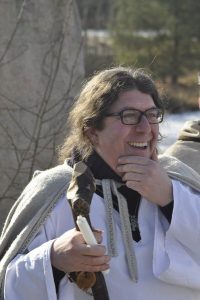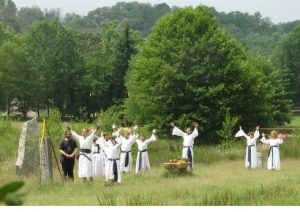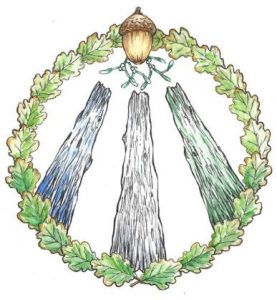CERCHIO DRUIDICO ITALIANO (ITALIAN DRUIDIC CIRCLE) TIMELINE
1970: Luigi “Ossian” D’Ambrosio was born in Nordhorn, Germany.
1980: D’Ambrosio moved to Biella, Italy, with his family.
1994: The Branco dell’Antica Quercia (The Ancient Oak Pack) was established and the website launched.
1996: The group celebrated its first Beltane Festival at Zumaglia Castle (Biella, Italy).
1998: The Branco dell’Antica Quercia became the Antica Quercia (The Ancient Oak).
2001: D’Ambrosio married and received his first initiation.
2002-2003: The festival location moved to Magnano (Biella, Italy) and then to Mottalciata (Biella, Italy).
2003: Antica Quercia joined the Circolo dei Trivi (the Wiccan group set in Milan) for the organization of the second National Convention on Wicca that took the name of “The Council of Druids and Witches.” The partnership between Antica Quercia and Circolo dei Trivi became one of the most durable in the Italian neopagan landscape.
2005: The festival took place at Arcobaleno Park in Masserano (Biella, Italy).
2008 (May): The Cerchio Druidico Italiano (Italian Druidic Circle) was established up during the Beltane Festival in Masserano.
2008 (June): During the midsummer solstice celebration, D’Ambrosio created guidelines for the Cerchio Druidico.
2008 (October): Philip Carr Gomm, president of The Order of Bards, Ovates and Druids, conducted a seminar for the first time in Italy.
2009: D’Ambrosio was invited to celebrate the Summer Solstice in Stonehenge.
2015: Antica Quercia, Circolo dei Trivi and several pagan associations created Unione delle Comunità Neopagane (UCN Italia – Union of Neopagan Communities).
2016: The twentieth Beltane Festival was celebrated in Masserano (Biella, Italy).
2018 (May): Caroline Wise, president of the Fellowship of Isis, came to the Beltane Festival to celebrate the Cerchio Druidico’s tenth anniversary.
FOUNDER/GROUP HISTORY
The Cerchio Druidico Italiano is a spiritual movement based on the ancient spirituality of the Celts, rediscovered for the first time in the eighteenth century on the British Isles. The movement changed and adapted to sociocultural circumstances and to other movements, such as occultism. Cerchio Druidico spread throughout Europe and arrived in Italy during the 1990s, intertwining re-enactment and spirituality. That is, some associations are born as reminiscent and later face spirituality, while others are born as explicitly spiritual but then face the historical discourse to discover the ancient Celtic past. Historical studies cause these cultural associations to face the break with the pagan past in two different ways: on the one hand, there are those who call themselves reconstructors; on the other hand, there are those who admit the reinvention of tradition.
Elaborating a chronology of Italian groups is a complicated operation since many have lifespans that do not exceed twenty years, and they often alter their names multiple time and/or change leaders. The first appearances that can be documented date back to 1996 with the birth of the Festival of Beltane in Biella, organized by the Cultural Association Antica Quercia (initially established in 1992) and Celtica (organized in the Aosta Valley by the Mor Arth Association). Also in 1996, the Cultural Association Terra Insubre was established in Varese, where it deals with historical and archaeological research on Alpine, Celtic and Germanic peoples. Unlike other groups claiming to be apolitical, this one has a more explicit political mission. In 1998, the first Trigallia International Celtic Festival was held; it then took place every two years until 2005, when its last event occurred. This event was replaced by the Trigallia Celtic Cultural Association, founded again in 1998 following the success of the festival.
It was a few years later that openly spiritual groups began to appear. The first, the Reformed Spiritual Movement of Insubria Natives, dates to 2003, but it survived for only a few years. In 2008, the Cerchio Druidico Italiano was created during the Beltane festival of that year. There were two other relevant but transitory groups, the Italian Bardica and Druidic Academy (OLNO, Oltre la Nona Onda) and the Grand Druidic Lodge of Italy (GralDrui). In Italy, there is also a national section of the OBOD that offers an online course.

The founder and leader of Cerchio Druidico Italiano is Luigi “Ossian” D’Ambrosio. [Image at right] Ossian was born in Nordhorn, Germany in 1970. During his childhood, his family moved to Biella, Italy, where he has continued to live. He is an artisan jeweler and a journalist on esotericism. He is also a musician. In 1988, he founded the Opera IX, a black metal band that is among the most long-running in Italy. This bond with music is very important to him, because it is through this musical genre that he approached paganism for the first time during his adolescence, thanks to the lyrics of various foreign bands.
His spiritual path has been multifaceted. He initially approached the first forms of organized Italian neopaganism, associations connected to modern witchcraft. He appreciated their structure and activities, but he didn’t recognize himself in that spirituality. Consequently, he began to research neopaganism and met Emanuele Pauletti, who became his mentor. Pauletti was associated with the Breton Druidic tradition and lead Ossian to seek more direct links with the northern Italian territory. Then, he studied shamanism at the Michael Harner Shamanic Studies Foundation and discovered Celtic shamanism. During his research, he founded his first association in 1994, Branco of the Antica Quercia (Ancient Oak Pack), which later became the Anticaquercia Association, through which he organized the first Beltane Festival in 1998. The main objective of the Association was research and profile-raising.
The Beltane Festival is one of the longest-running Celtic Italian festivals; it was established at Arcobaleno Park in Masserano, Biella. During the 2008 Beltane Festival, the Cerchio Druidico Italiano (Italian Druidic Circle) was founded. As Ossian recounts in his book, La via delle querce (2013), the birth of the Cerchio Druidico allowed a division of interests between the two different associations, leaving them free to better focus on certain features: the Antica Quercia Association (Antica Quercia Association website n.d.) deals with the most artistic and cultural side, while the Cerchio engages itself in the spiritual path, allowing the creation of a more neo-druidic space within the group.
In October of the same year, Philip Carr Gomm (The Order of Bards, Ovates and Druids’ president) was invited by D’Ambrosio and Davide “Cronos” Marré (the Circolo dei Trivi’s president (the first Italian Wiccan coven, in Milan) to give a seminar. That seminar was one of the most important events for the Cerchio Druidico Italiano as it served as an educational moment for the entire membership.
In 2009, D’Ambrosio became the first Italian Druid invited to the celebration of the Summer Solstice in Stonehenge, which is celebrated by The Order of Bards, Ovates and Druids (OBOD).
DOCTRINES/BELIEFS
Neo-druidism is one of the movements in the broader category of Neopaganism; movements in this category share in common the project of revitalizing or reconstructing the traditions of pre-Christian polytheistic cults (Harvey 2016). There are two different and antipodal ways to live neo-druidism in Italy: some interpret spirituality as a lifestyle potentially applicable to any religion while others live it as a religion. Cerchio Druidico Italiano follows this second path and is the only group in northern Italy that offers such an explicit spiritual path.
The group puts into practice a process of reinvention of tradition. Their leader is aware of the rift with the ancient tradition caused by the advent of Christianity. He has not sought to reclaim the earlier Celtic spirituality, given the difficulties of accurate historical reconstruction (D’Ambrosio 2013). Rather, the Cerchio Druidico offers a contemporary spiritual path in order to create a deep link between humans and nature. They envision a connection with the land, a sort of rediscovery of the history and the peculiarity of the territory where people have lived. The goal is to create a neopagan community based on mutual support and self-responsibility. The aim is clearly ecological and is consistent with neopagan movements as nature-based religions (Harvey 2016).
Indeed, Cerchio Druidico Italiano puts ecopaganism at the centre of its spirituality and practice. Its ecological activism is entrusted to the sensitivity of the individual, but what the group proposes is a practical and constant action in order to establish positive relations between the human being and other living creatures. The objective is to restore humanity back to its place in nature in order to allow peaceful coexistence. The ethical mission of neopaganism is revealed by the choice of the place where Cerchio Druidico Italiano holds its meeting. The group chose Arcobaleno Park, a private park in a protected area that is in environmental recovery, as it is an abandoned quarry.
This link with nature is also expressed in the representation of divinities. Neopaganism shares with neodruidism placing bi-theism at the centre of its beliefs; The God and The Goddess thus represent two aspects of the universe. This allows them to propose that every deity humanity has ever conceived over the centuries is no more than the manifestation of a specific aspect of these two entities.
RITUALS/PRACTICES

Cerchio Druidico Italiano shares with broader Neopaganism the Wheel of the Year, a cyclic annual calendar with eight seasonal festivities.[Image at right] Half of these festivals are solar and the other half are lunar; the most recent are defined as fire festivals. This is a canon common to every contemporary Paganism, with names having been reconstructed by different traditions (Hutton 2008). Only the celebrations of Samhain and Beltane are public; the others are all private for the members of Cerchio Druidico.
Solar festivities are agro-pastoral celebrations. Cerchio Druidico uses the names proposed by the Bard Iolo Morgangaw rather than the more traditional titles (Yule, Ostara, Litha and Imbolc):
The Spring Equinox, Alban Eiler (Earth’s Light), falls between March 21 and 22.
The Winter Solstice, Alban Arthuan (Arthur’s Light), falls between December 20 and 23.
The Summer Solstice, Alban Hefin (Shore’s Light), falls between June 20 and 23.
The Autumn Equinox, Alban Elfed (Water’s Light), falls between September 20 and 21.
Fire festivities are:
Samonios, celebrated between October and November, is the Celtic New Year’s Day.
Brigantia/Imbolc, celebrated in the first days of February.
Beltane, celebrated in the first days of May.
Lugnasa, celebrated in the first days of August.
For these ceremonies, members of Cerchio Druidico Italiano meet in an open space in nature, usually Arcobaleno Park. They gather in a circle and follow a ritual on a script the group has developed. These ceremonies all have the same primary structure: the circle opens; there is a greeting and calling for the four cardinal points and the respective divinities; specific ritual gestures of the holiday are performed; the circle then closes, dismissing the forces previously called. Each ceremony draws on folkloristic elements from different traditions. An integral part of the ceremony is the following meal shared by the group. In this way, sacred and profane aspects merge, blurring the boundaries between the two and allowing the creation of a space of conviviality among the members.
In addition to these festivities linked to the Wheel of the Year, there are many other ritual moments, mainly connected with group members’ life cycles. The Welcome Rite and the New-born Presentation to the community happens when parents give the child his/her name in front of the whole group. Other ritual moments follow the most important events in the child’s life (e.g. losing the first tooth or the first day at school). The second and third rituals are the Sacred Union and Separation. The Sacred Union is a marriage where a couple presents itself as a family; Separation is the ritual redefining the relationship with the whole group in case the former fails. Sacred marriages are offered both during the year and during the Feast of Beltane and are celebrated not only by Ossian but by each member of Cerchio Druidico who has achieved initiation. Finally, there is the Transition Rite, the funerals or memorials to honour the elders. Other ritual moments are dedicated to the initiation of group members. These rites are the first and last steps of a specific spiritual path.
ORGANIZATION/LEADERSHIP

Cerchio Druidico celebrated its first ten years of life in May 2018, and during this decade so many participants joined the group that an independent “grove” had to be created: the Triplice Cinta Druidica. [Image at right]
The structure of Cerchio Drudico Italiano is peculiar: Ossian is its centre and engine, but the group denies any form of pyramidal power in favour of a circular assembly. The group’s position is that a leader is needed to coordinate the actions of the different members who, like pieces of a gear, must take care of each one of their tasks (D’Ambrosio 2013).
The spiritual path in Cerchio Druidico consists of three steps: bard, ovate and druid. During the bard stage, neophytes must work on their creativity and their emotional sphere. Neophytes become Bards after attending the Cerchio Druidico for a year and a day. At that point they are “dedicated.” The Ovate is a doctor and a fortune-teller. Ovates are now identified with shamans because they are the ones who can move between both worlds. Again, after a year and a day the person is initiated into Cerchio Druidico.
Bards are preservers of the historical memory of the people. They are the artists who preserve and transmit tradition through their work. They are the ones who make ideas tangible, thus manifesting the will of the divinity. The symbolism linked to this figure is varied. Bards are assigned the colour blue, the water element and the West direction; the season is spring and the tree is the birch (“beith”), both symbols of the beginning (D’ambrosio 2013).
What inspires the Bard is the Awen, one of the main elements of modern Druidism. It is the name and symbol that Iolo Morgangw assigns to inspiration, which enables the Goddess to speak through the Bard. In many bardic ceremonies there is a moment when songs are dedicated to the invocation of the Awen that must descend over the participating Bards to inspire them for the performance (Harvey 1997). Cerchio Druidico in this is no exception; in all ceremonies there is a moment at the beginning during which the Awen is invoked in chorus to inspire and connect the divinity with the participants.
Ovates are shamans and healers. They are the ones who travel between worlds, being able to speak with what is more than human. Thanks to this ability, they can also perform the function of seers and interpret messages from the gods. This connection with the divine allows a profound connection with nature to be taken care of by the modern Ovate. The colour associated with the Ovate is green, the seasons are autumn and winter, the night is its moment, and the associated Ogham tree is the yew (Harvey 1997; D’ambrosio 2013).
Modern Druid functions are carried out in nature and in the recovery of rituals set in the woods that serve to recreate the link with the environment. Associated with the druid are the colour white, the oghamic trees of the oak and the mistletoe, the East direction, where the sun rises, and the summer season.
ISSUES/CHALLENGES
Cerchio Druidico has faced both internal and external issues. Internally, the group has attempted to create a network with other Italian druidic groups. However, that effort has not yet been successful as the various groups have been unable to agree on spiritual guidelines
Externally, Cerchio Druidico is located outside the Catholic cultural mainstream in Italy and therefore has been vulnerable to being labelled a “cult” (Wallis 1976). Although members are in fact well integrated into Italian society, they sometimes conceal group membership to avoid a negative label. The group is seeking to counter negative attribution by joining in the “Article 8 Project.” This project is supported by the Unione delle Comunità Neopagane (UCN), a coalition of associations, groups and individual pagans (Unione delle Comunità Neopagane website n.d.). The goal of UCN is the recognition of a neopagan religion by the Italian government or, alternatively, the recognition of different individual neopagan groups. Government recognition would be a significant step in gaining public acceptance.
IMAGES
Image #1: Luigi “Ossian” D’Ambrosio.
Image #2: A Cherchio Druidico ritual gathering.
Image #3: The Cherchio Druidico logo.
REFERENCES
AnticaQuercia. n.d. Antica Quercia website. Accessed from http://www.anticaquercia.com on 10 June 2018.
Cerchio Druidico Italiano. 2016. Il Druidismo Moderno del Cerchio Drudico Italiano: Testo Introduttivo.
Cerchio Druidico Italiano. 2012. Cerchio Druidico Italiano website. Accessed from http://www.cerchiodruidico.it on 10 June 2018.
D’Ambrosio, Ossian. 2013. La via delle querce. Introduzione al druidismo moderno, Psiche 2.
Harvey, Graham. 2016. “Paganism.” Pp. 345-67 in Religions in the Modern World, edited by Linda Woodhead, Christopher Partridge and Hiroko Kawanami, London: Routledge.
Harvey, Graham. 1997. Listening People, Speaking Earth, Contemporary Paganism, New York: New York University Press.
Hutton, Ronald. 2008. Modern Pagan Festival: A Study in the Nature of Tradition, Folklore 119:251-73.
Wallis, Roy. 1977. The Road to Total Freedom. A Sociological analysis of Scientology, New York: Columbia University Press.
Unione delle Comunità Neopagane website. n.d. Accessed from http://www.neopaganesimo.it/ on 20 March 2019.
SUPPLEMENTARY RESOURCES
Harvey, Graham. 2011. Contemporary Paganism: Religions of the Earth from Druids and Witches to Heathens and Ecofeminists, Second Edition. New York: New York University Press.
Post Date:
12 November 2019
